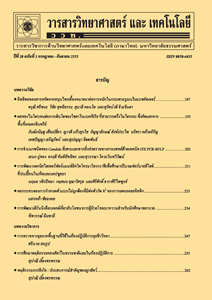การศึกษาระดับทองแดง แมกนีเซียม ซีลิเนียม และสังกะสีในผู้สูงอายุชาวไทยที่มีภาวะเมแทบอลิกซินโดรมและระดับน้ำตาลในเลือดสูง
Main Article Content
Abstract
Abstract
Copper, magnesium, selenium and zinc play the important roles in metabolism. A cause of metabolic syndrome is occurred from metabolism changing which related these trace elements changing. Aim: To study the copper magnesium selenium zinc levels in Thai elder with metabolic syndrome and hyperglycemia. Methods: Analysis of copper, magnesium, selenium and zinc levels of participants who were checked-up at Sirindhorn Hospital during December 2017 to January 2018. For case-control study design, control A was a middle-aged group without metabolic syndrome and normal blood sugar level and control B was an elder aged group without metabolic syndrome and normal glucose level. Case C was an elder aged group with metabolic syndrome and hyperglycemia. Results: Case C group: Mean and standard deviation of copper, magnesium, selenium and zinc were 0.127±0.029 mg/dL, 2.002±0.294 mg/dL, 73.176±46.819 ng/mL, 0.097±0.057 mg/dL respectively. Four trace elements of case C group were lower than control A and B groups. Spearman rank correlation analyzed that magnesium and selenium were significantly correlated with metabolism syndrome and hyperglycemia (p<0.001). Conclusion: The low level of magnesium and selenium were effected by metabolism decreasing in the elders. These effects caused by metabolic syndrome with hyperglycemia. Therefore, prevention of other diseases will occur in the future, the elders should be educated and recognized their health.
Keywords: copper; magnesium; selenium; zinc; metabolic syndrome
Article Details
References
[2] สำนักงานวิจัยนวัตกรรมและพันธมิตร มหาวิทยาลัยเทคโนโลยีพระจอมเกล้าธนบุรี, 2559, บทสรุปสำหรับผู้บริหาร ยุทธศาสตร์การวิจัยรายประเด็นด้านผู้สูงอายุและสังคมสูงอายุ (พ.ศ. 2556-2559), แหล่งที่มา : https://www.kmutt.ac.th/rippc/nrct59/34s10.pdf, 12 เมษายน 2559.
[3] คณะอนุกรรมการจัดทำข้อมูลสถานการณ์ผู้สูงอายุ, 2547, สถานการณ์ผู้สูงอายุไทย, แหล่งที่มา : https://wvvw.m-society.go.th/document/edoc/edoc_890.pdf, 12 เมษายน 2559.
[4] Chen, Y., Saari, J.T. and Kang, Y.J., 1994, Weak antioxidant defenses make the heart a target for damage in copper-deficient rats, Free Radic. Biol. Med. 17: 529-536.
[5] Guerrero-Romero, F. and Rodriguez-Moran, M., 2002, Low serum magnesium levels and metabolic syndrome, Acta Diabetol. 39: 209-213.
[6] Kao, W.H., Folsom, A.R., Nieto, F.J., Mo, J.P., Watson, R.L. and Brancati, F.L., 1999, Serum and dietary magnesium and the risk for type 2 diabetes mellitus: The atherosclerosis risk in communities study, Arch Intern Med. 159: 2151-2159.
[7] Kryukov, G.V., Castellano, S., Novoselov, S.V., Lobanov, A.V., Zehtab, O., Guigó, R. and Gladyshev, V.N., 2003, Characterization of mammalian selenoproteomes, Science 300: 1439-1443.
[8] Salonen, J.T., Alfthan, G., Huttunen, J.K. and Pikkarainen, J., 1982, Association between cardiovascular death and myocardial infarction and serum selenium in a matched-pair longitudinal study, Lancet 24: 175-179.
[9] Jansen, J., Karges, W. and Rink, L., 2009, Zinc and diabetes-clinical links and molecular mechanisms, J. Nutr. Biochem. 20: 399-417.
[10] Heynemen, C.A., 1996, Zinc deficiency and taste disorders, Ann. Pharmacother. 30: 186-187.
[11] Chen, M.D., Lin, P.Y., Cheng, V. and Lin, W.H., 1996, Zinc supplementation aggravates body fat accumulation in genetically obese mice and dietary-obese mice, Biol. Trace Elem. Res. 52: 125-132.
[12] Blonstein-Fujji, A., DiSilvestro, R., Frid, D., Katz, C. and Malarkey, W., 1997, Short term zinc plasma 5'-nucleosidase activities, insulin-like growth factor 1 concentrations and lipoprotein oxidation rates in vitro, Am. J. Clin. Nutr. 66: 639-642.
[13] Simon, S.F. and Taylor, C.G., 2001, Dietary zinc supplementation attenuates hyper glycemia in db/db mice, Exp. Biol. Med. (Maywood) 226: 43-51.
[14] Paul, L., 2009, A comprehensive definition for metabolic syndrome, Dis. Model Mech. 2: 231-237.
[15] Pongchaiyakul, C., Nguyen, T.V., Wanothayaroj, E., Krusun, N. and Klungboonkrong, V., 2007, Prevalence of metabolic syndrome and its relationship to weight in Thai population, J. Med. Assoc. Thai 90: 459-467.
[16] สมาคมความดันโลหิตสูงแห่งประเทศไทย, 2558, แนวทางการรักษาโรคความดันโลหิตสูง เวชปฏิบัติทั่วไป, แหล่งที่มา : https://www.thaihy pertension.org/files/GL%20HT%202015.pdf, 17 พฤษภาคม 2561.
[17] Arnaud, J., de Lorgeril, M., Akbaraly, T., Salen, P., Arnout, J., Cappuccio, F.P., van Dongen, M.C.J.M., Donati, M.B., Krogh, V., Siani, A., Iacoviello, L. and on behalf of the EEuropean Collaborative Group of the IMMIDIET Project, 2012, Gender differences in copper, zinc and selenium status in diabetic-free metabolic syndrome European population - the IMMIDIET study, Nutr. Metab. Cardiovasc. Dis. 22: 517-524.
[18] Rotter, I., Kosik-Bogacka, D., Dołęgowska, B., Safranow, K., Lubkowska, A. and Laszczyńska, M., 2015, Relationship between the concentrations of heavy metals and bioelements in aging men with metabolic syndrome, Int. J. Environ. Res. Public Health 12: 3944-3961.
[19] Asayama, K., Kooy, N.W. and Burr, I.M., 1986, Effect of vitamin E deficiency and selenium deficiency on insulin secretory reserve and free radical scavenging systems in islets: Decrease of islet manganosuperoxide dismutase, J. Lab. Clin. Med. 107: 459-464.
[20] Siddiqui, K., Bawazeer, N. and Joy, S.S., 2014, Variation in macro and trace elements in progression of type 2 diabetes, Sci. World J. 2014: 1-9.
[21] Naka, T., Kaneto, H., Katakami, N., Matsuoka, T., Harada, A., Yamasaki, Y., Matsuhisa. M. and Shimomura, I., 2013, Association of serum copper levels and glycemic control in patients with type 2 diabetes, Endocr. J. 60: 393-396.
[22] Ferdousi, S. and Mia, A.R., 2012, Serum levels of copper and zinc in newly diagnosed type-2 diabetic subjects Mymensingh, Med. J. 21: 475-478.
[23] Obeid, O., Elfakhani, M., Hlais, S., Iskandar, M., Batal, M., Mouneimne, Y., Adra, N. and Hwalla, N., 2008, Plasma copper, zinc, and selenium levels and correlates with metabolic syndrome components of lebanese adults, Biol. Trace Elem. Res. 123: 58-65.


